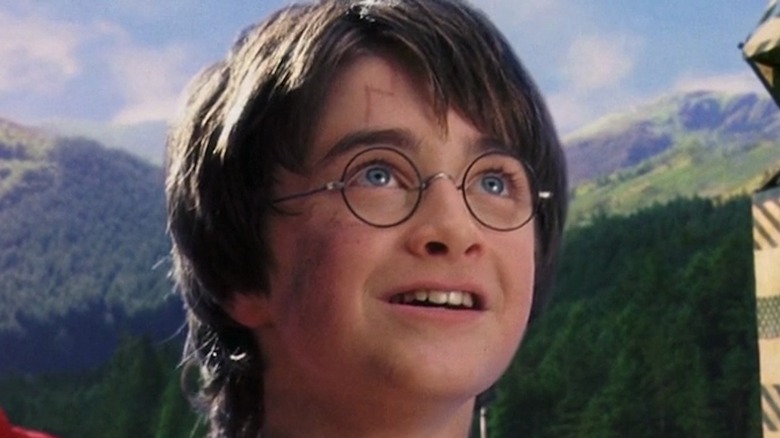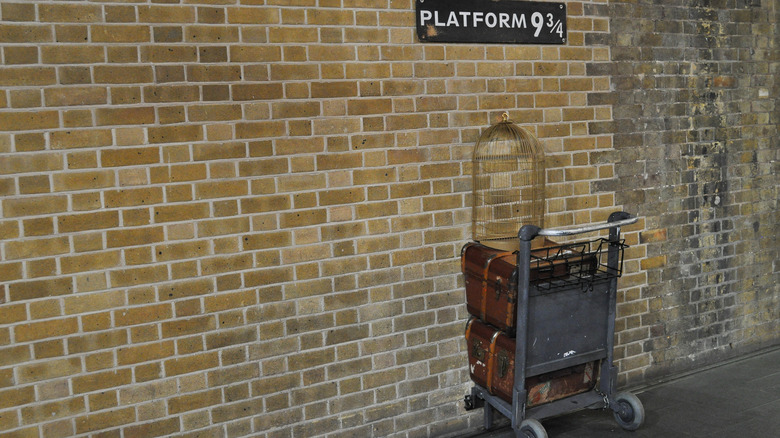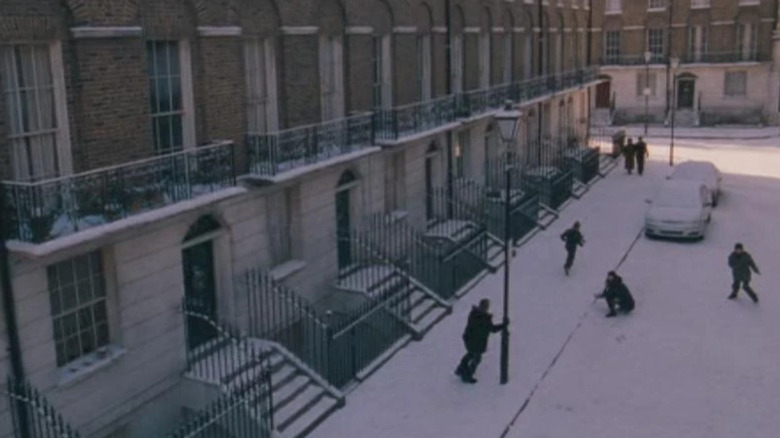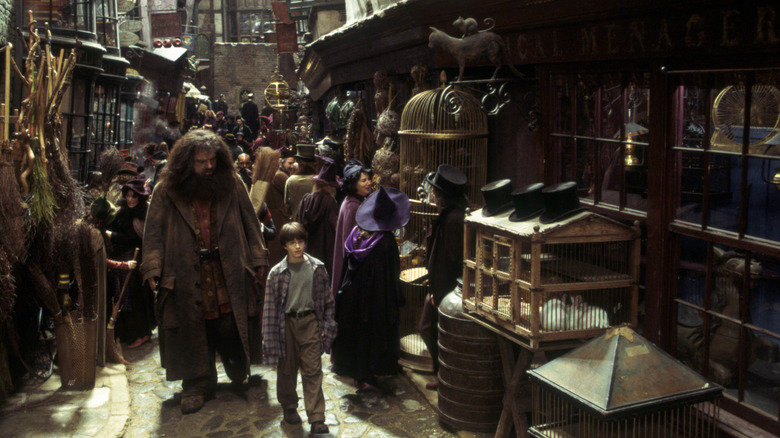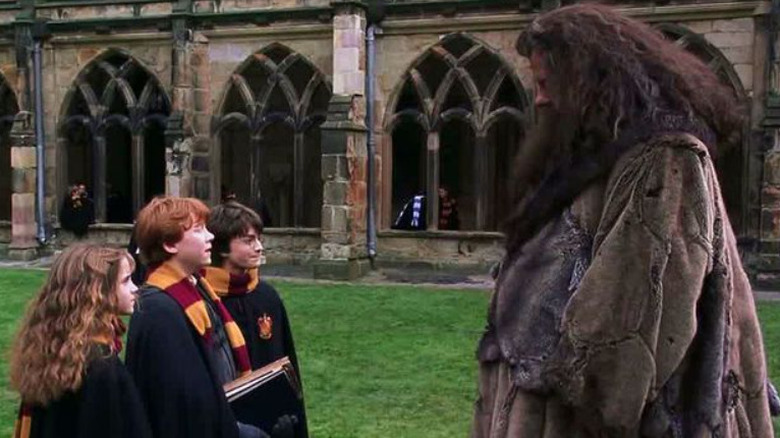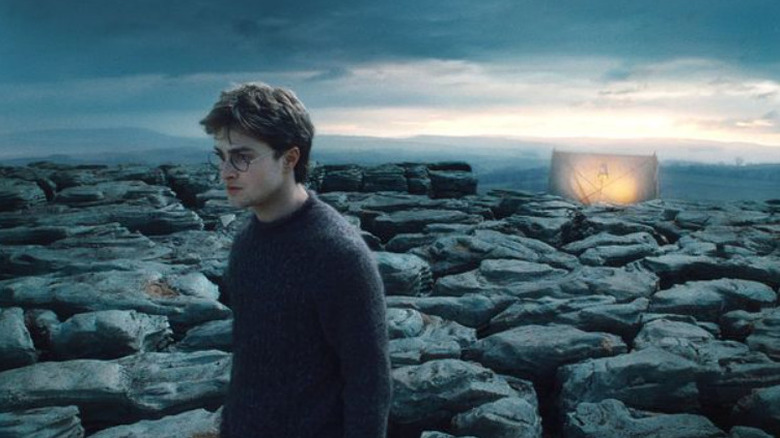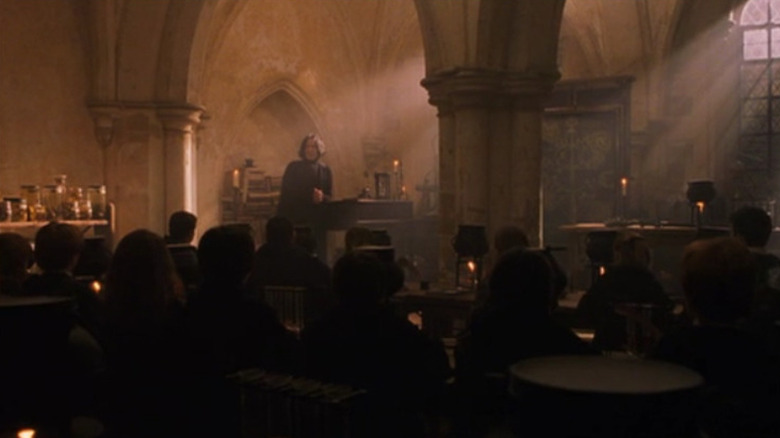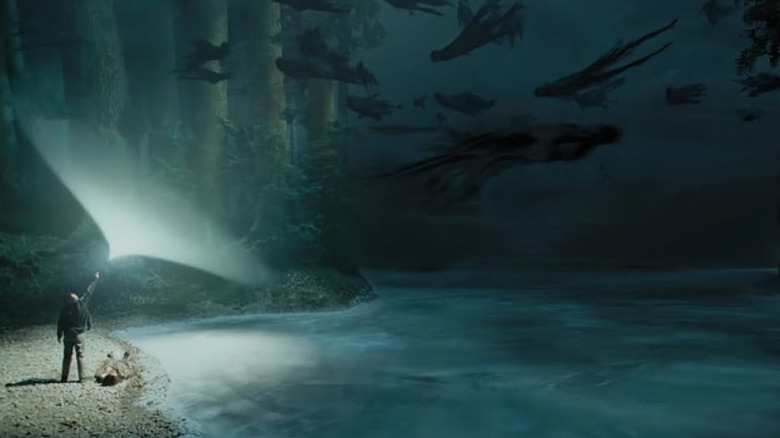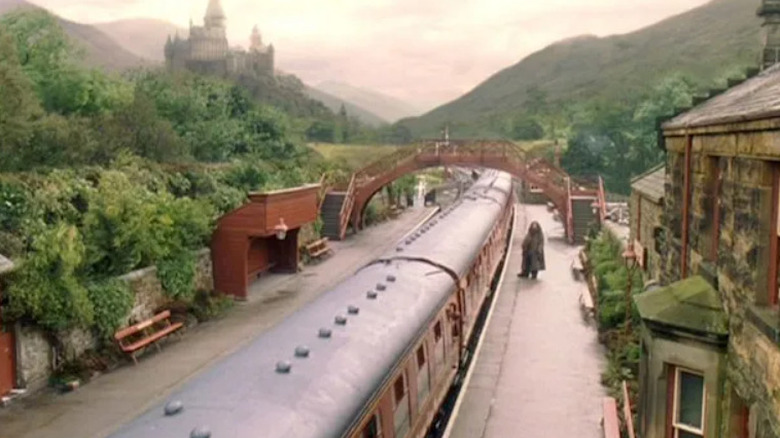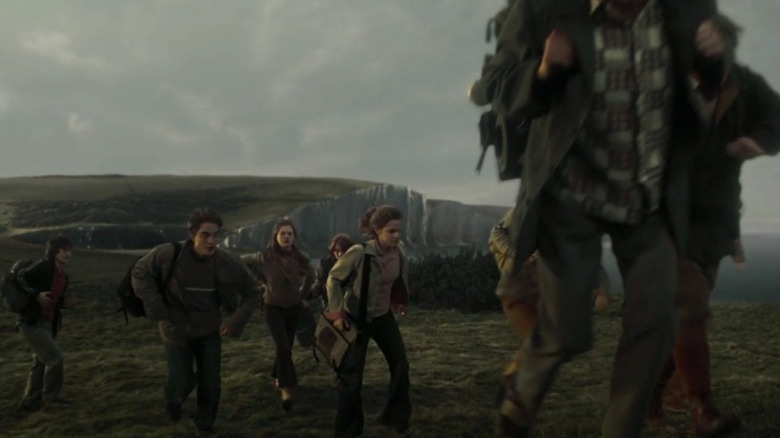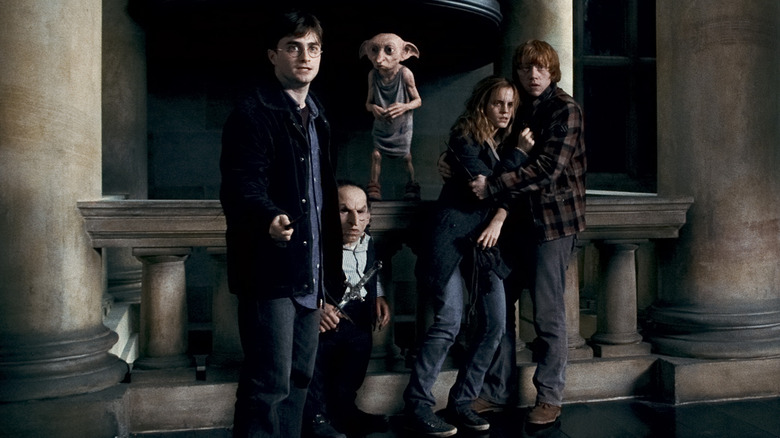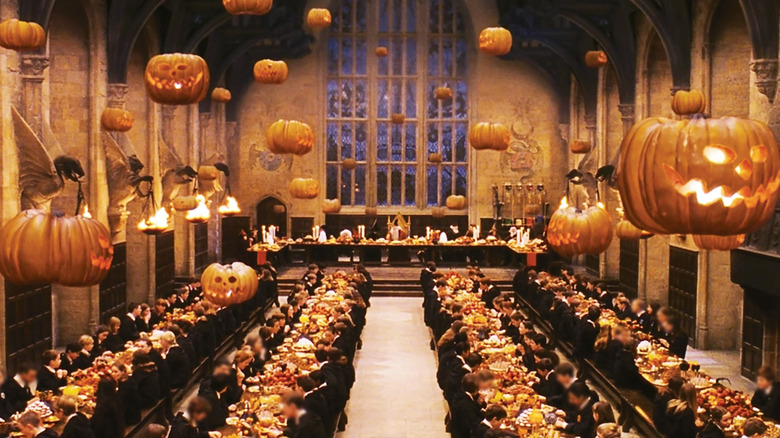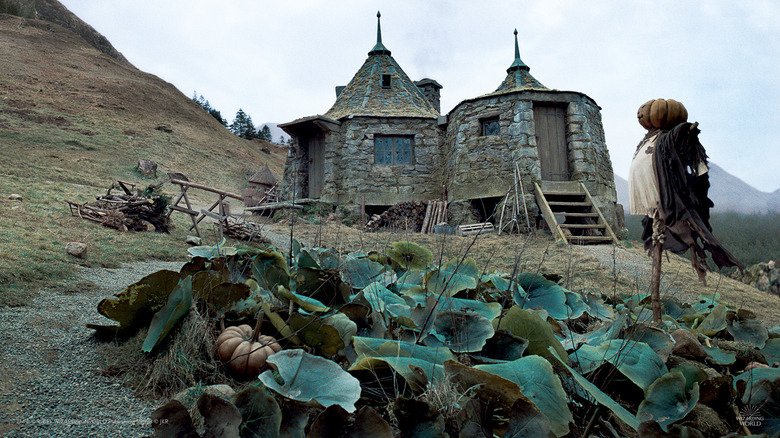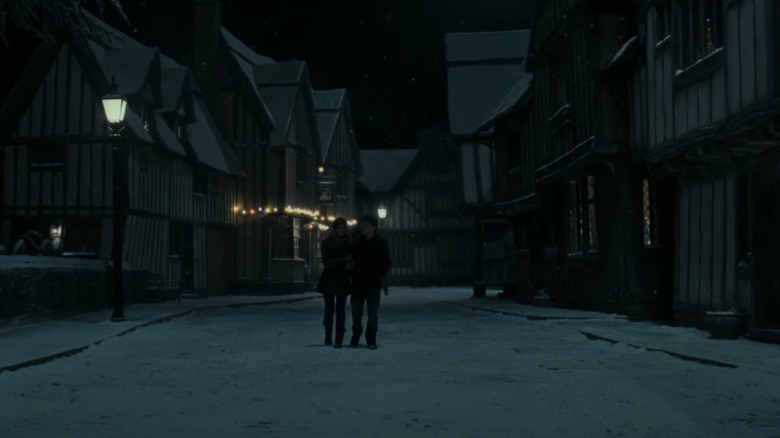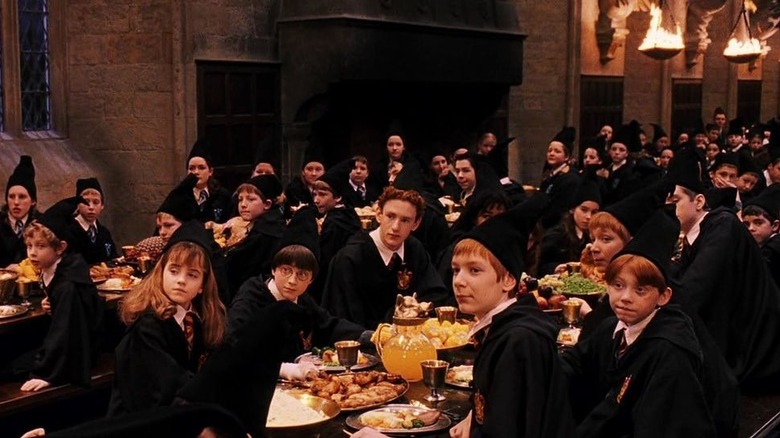Harry Potter Movie Locations You Can Visit In Real Life
More than two decades ago, the publishing world was taken by storm with the release of 1997's "Harry Potter and the Philosopher's Stone," a children's novel by J.K. Rowling. The book told the story of a young orphan named Harry, who discovers he has magic powers and is sent to Hogwarts, School of Witchcraft and Wizardry to learn to control his abilities.
Thus was created a literary phenomenon whose popularity is unmatched by any other book series in recent times. Soon Hollywood came calling and the "Harry Potter" cinematic franchise was born, resulting in eight main movies, a prequel trilogy and many more spinoffs in other forms of media, from video games to stage plays.
An entire generation of fans have grown up alongside Harry (Daniel Radcliffe) and his best friends Ron (Rupert Grint) and Hermione (Emma Watson) as they explore the wizarding world laid out in the "Harry Potter" movies. While a lot of the film scenes were shot in studios, the producers also made ample use of real-life locations and architecture to bring a deeper level of authenticity to the films. Let us take a look at some such locations that you can visit in real life.
King's Cross Station
Perhaps the most iconic location from the "Harry Potter" movies outside of Hogwarts itself. London King's Cross railway station is a real-life location that was included in J.K. Rowling's novels as the place where you will find Platform 9 ¾, the secret location protected by a magical barrier where students await the arrival of the Hogwarts Express.
So great is the popularity of the "Harry Potter" books and movies that the authorities at King's Cross have actually included references to the magical platform on a permanent basis. After undergoing extensive refurbishment for the whole of King's Cross, the entrance to the mythical Platform 9¾ was built in the main concourse area near a shop that sells "Harry Potter" merch. It is denoted via a plaque and luggage trolley that appears to be stuck halfway through the magical entrance.
But be warned, the description of the area might be different from what you read in the books. As Rowling once admitted to BBC, "I broached Platform 9 ¾ when I was living in Manchester, and I wrongly visualized the platforms, and I was actually thinking of Euston, so anyone who's actually been to the real platforms 9 and 10 in King's Cross will realize they don't bear a great resemblance to the platforms 9 and 10 as described in the book. So that's just me coming clean, there. I was in Manchester; I couldn't check."
12 Grimmauld Place
For a long time, Harry had no place to truly call his home. His life at the Dursleys residence was intolerable, and as great as Hogwarts was, he was only one of the many students paying a tuition to get to live there. But then things changed when Harry discovered his godfather, and his father's best friend, Sirius Black (Gary Oldman).
For a time, Harry dreamt of living with Sirius in a home of his own. Sirius came from a wealthy family, and he owned a huge but dilapidated house, 12 Grimmauld Place. After Sirius' tragic passing, Harry became the new owner of the house, and he found it a convenient place to lie low with Ron and Hermione when they were being hunted by Lord Voldemort and his army of Death Eaters.
In the films, The Claremont Square area of London was used to shoot the exteriors of Number 12, Grimmauld Place. If you find yourself visiting King's Cross station, Claremont Square is a brief walk away near Pentonville Road. While the exteriors of Grimmauld Place were taken from that area, the interior shots of the house were filmed in studios, so don't get your hopes up for going inside the building to see the Black Family Tree Tapestry on the wall.
Diagon Alley and the Leaky Cauldron
After Harry's life is turned upside down with the revelation that he is a wizard, the 11-year-old is taken by Rubeus Hagrid (Robbie Coltrane) to Diagon Alley to get school supplies. The entrance to the magical alley is at the back of a wizarding pub called the Leaky Cauldron. Arriving at the cobblestone alley, Harry bears witness for the first time to the secret world of magic he had never known about but always belonged to.
Diagon Alley is another iconic landmark for "Harry Potter" fans, and the place so many dream of visiting so they can buy their own magic wand from Mr. Ollivander's shop, visit Weasleys' Wizard Wheezes to get some gag gifts, or maybe even visit Gringotts Wizarding Bank just to see the goblin workers. In reality, much of what you remember of Diagon Alley was created in studios and later dismantled.
However, many of the exterior shots for the Leaky Cauldron and Diagon Alley were taken near Leadenhall Market in London. Leadenhall serves as a "covered market" area located on Gracechurch Street. You can roam around the market for free, shopping for strange knicks-knacks and pretend you are gathering supplies for a trip to Hogwarts.
Arriving at Hogwarts
While Harry Potter and his friends go to all sorts of places over the span of the movies, the centerpiece of the whole thing has always been Hogwarts School of Witchcraft and Wizardry. The imposing castle, with the endless corridors, the many secret rooms and passages, and the sinister Forbidden Forest right at the edge have all inflamed the imaginations of viewers for two decades.
Naturally, such a huge location could not be shot all in the same place. The interior and exterior shots of Hogwarts and its surroundings have been filmed in an assortment of real locations, on sound stages, and using small scale models. One real-life location in the mix was Durham Cathedral.
In the first two movies in the series, various parts of the Cathedral were transformed into parts of Hogwarts. One part called "The cloisters" appeared in a number of scenes as the school's courtyards. Also Professor McGonagall's classroom was shot in the Chapter House, and the interior gallery known as the "Triforium" was the stand-in for the Forbidden Corridor. You can take guided tours of the Cathedral and the surrounding area, which has been deemed a world heritage site by UNESCO.
Go camping with Harry and Hermione
In 2010's "Harry Potter and the Deathly Hallows — Part 1," the assault from Voldemort (Ralph Fiennes) on the wizarding world is already underway. Hogwarts is no longer a safe place for Harry, Ron, Hermione to stay at as they try to figure out how to track down and destroy the remaining horcruxes, including the cursed locket in their possession.
The combined pressure of being constantly on the run from the Death Eaters in the wilderness while struggling to figure out the next step of their plan takes a toll on the three best friends. Ron is the first one to break, and he leaves the group. That leaves Harry and Hermione trying to carry on without him, in which capacity they camp briefly on a collection of rock formations while poring over the clues Dumbledore left them.
That particular camping scene was filmed at Malham Cove. The cove, which is a limestone formation in Northern England, was formed thousands of years ago by the water from a waterfall fed from a glacier. Malham Cove can be found near the Yorkshire village of Malham. Hiking trips are popular across the cove, and the place is free to visit for all.
Potions class
For the longest time, Hogwarts was the only home Harry knew, a place where he finally felt like he belonged. But it wasn't all cakes and roses at the school 24/7. There was one place in the giant castle that Harry grew to positively dread, and that was the room in which Severus Snape taught potions to Harry and his peers.
The potions class became the site of great humiliation for Harry as Snape relentlessly picked on him in front of the other students. But the class was also an impressive place to bear witness to, seeing a group of young wizards being taught by a master potion maker to create impossible liquids that could do anything from change your appearance to giving you unbelievable good luck.
Lacock Abbey was the spot that was used in the movies to depict Snape's class. More specifically, "The Sacristy" part of the Abbey doubled as the room in which Snape so frequently tormented Harry in front of his classmates. Additionally, the cloisters of Lacock Abbey were used to depict the ornate corridors of Hogwarts castle. The Lacock Abbey Chapter House is the place where Harry discovered the Mirror of Erised. Finally, Quirrel's classroom in the first movie was shot in the section of the Abbey called "The Warming Room."
Hogwarts Lake
Hogwarts wasn't just a castle, but an entire giant estate that included expansive grounds and a lake where lurked a massive deep sea creature named "The Giant Squid." The lake was the scene of great action in the "Harry Potter" movies, where Harry sailed on top of a hippogriff in his third year, and dived into the lake's icy depths as part of the Triwizard Tournament the next year.
The famous lochs in Scotland were the main filming locations for Hogwarts' Great Lake. But some parts of the lake were filmed at Virginia Water in Surrey as well. Most notably, it was at the edge of Virginia Water Lake that Harry had his famous standoff against an army of dementors at the end of "Harry Potter and the Prisoner of Azkaban."
Apart from being the place where many "Harry Potter" scenes were shot, Virginia Water is a great place to visit for its natural beauty. Particularly the man-made Cascade waterfalls which can be a great place for a quick photo session.
Hogsmeade Station
While earlier movies kept the action centered around Hogwarts, later "Harry Potter" films started exploring the area outside of the castle and its grounds. Hogsmeade was a nearby all-wizarding village that Harry and his friends started frequenting from their third year.
Apart from the village itself, Hogsmeade Station was an important part of the narrative since that was where the Hogwarts Express disembarked its students at the start of every year. In reality, the role of the station at Hogsmeade was played by Goathland train station located in England's Goathland, Scarborough.
Since Goathland station is pretty small, many parts of its layout have shown up in the "Harry Potter" films. Possibly the most famous shot of the station appears at the end of "Harry Potter and the Sorcerer's Stone," when Harry climbs back onto the Hogwarts Express along with the other students for summer vacations, and they are waved off by Hagrid standing on the station platform.
The Quidditch World Cup
The most impossible dream that the "Harry Potter" series gave the world was the hope that someday we would all be able to fly around on broomsticks playing Quidditch. While Harry took part in many hair-raising Quidditch matches at Hogwarts, the biggest match of all was the Quidditch World Cup that Harry attended along with Ron's family in "Harry Potter and the Goblet of Fire."
Unfortunately, the World Cup match itself was not shown in the movie, but viewers did get to spend a lot of time with Harry and the others in the forest where the match was being held. That forest is actually Hertfordshire's Ashridge Wood, a 15.9-hectare Site of Special Scientific Interest that has been deemed an Area of Outstanding Natural Beauty.
Until a few years ago, Ashridge Estate was also home to an ancient yew tree thought to be several centuries old, that became the inspiration for the aggressive "Whomping Willow" tree that Harry and co. have a few run ins with. Unfortunately, the yew tree split apart in 2014 due to a combination of factors including ingrowing wood-decay fungi and chilly weather. You can still view the remains of the tree on your trip to Ashridge.
Malfoy Mansion
Over the course of eight films, Draco Malfoy (Tom Felton) went from being a school bully and a spoiled brat to an aspiring Death Eater, to an unwilling participant in Voldemort's crimes, to ultimately being not such a terrible guy after all. Much of Draco's character was informed by his parents, and the fact that he came from a wealthy pure-blood family.
Most of Draco's scenes took place at Hogwarts, but in the final part of the saga, Harry, Ron, and Hermione are briefly taken to Draco's house, Malfoy Manor. It is a predictably impressive building fallen into disrepair due to the absence of Draco's father and the fact that it was being used as one of the headquarters for Voldemort's army.
In real life, the scenes relating to Malfoy Manor were filmed at Hardwick Hall, an Elizabethan country house in Derbyshire. The hall was built in the 1500s by Elizabeth, Countess of Shrewsbury, who was believed to be the second richest person in Britain at the time. Quite a fitting source of inspiration for Malfoy Manor. While some parts of the manor were CGI, you can see the main parts of the building for real by visiting Hardwick Hall on a guided tour.
The Great Hall
The Great Hall is one of the most important locations of Hogwarts. A vast area with an enchanted ceiling and a bevy of ghosts, the Great Hall was a place where students were received upon first entering the castle, and where they had their daily food under the watchful eye of the cantankerous caretaker Argus Filch, and the equally watchful eyes of his cat Mrs. Norris.
Naturally, the enchanted ceiling part of the Great Hall and the thousands of floating candles etc. were not actually real. But the hall itself was inspired by a similar layout at Oxford's Christ Church College. The makers of the "Harry Potter" movies studied the architecture of "The Hall" at Christ Church, and then created its replica at their studios.
While visiting The Hall in Christ Church is not as magical an experience as visiting the hall at Hogwarts would be, it has its own rich history that is worth checking out. It bore the distinction of being the largest hall in Oxford until the 1870s and has been used as a place for feasting and celebration since the sixteenth century.
Hagrid's Hut
Despite being a rough and terrifyingly large half-man half-giant, Rubeus Hagrid was the first true friend Harry ever knew, and one of the most loyal. Hagrid was the groundskeeper at Hogwarts, and his modest hut became a home-away-from-home of sorts for Harry, and later for Ron and Hermione as well.
Given Hagrid's reckless love for all manners of large and wild creatures, it was only natural that his hut be located amidst a scenic wilderness that feels like it has been ripped straight out of a nature book. For the third Harry Potter film, "The Prisoner of Azkaban," scenes at and surrounding Hagrid's hut were filmed at one of Scotland's most famous and historic glens named "Glencoe."
The sets for Hagrid's hut were built near the bottom of Clachaig Gully in Glencoe. Unfortunately for those hoping to get their picture taken at Hagrid's hut, the sets were dismantled after filming was completed and the gully reverted to its natural state, leaving little trace that it was the spot where Harry and friends plotted to save Buckbeak the Hippogriff from the Ministry of Magic.
Harry Potter's birthplace
As an orphan, Harry Potter retained no memories of his childhood home, the place where he was born and where he spent the first year of his life until Voldemort came calling at his parents' doorstep. It was near the end of the saga, when Harry had become almost a fully-adult wizard that he was finally able to visit his birthplace in the village called Godric's Hollow.
The visit was naturally quite painful, as Harry imagined the place where his parents met their end, desperately trying to protect their son from the wrath of the most evil sorcerer of all time. For "Harry Potter and the Deathly Hallows — Part 1," the scenes at Godric's Hollow were filmed at De Vere House in Lavenham, Suffolk.
The 14th-century cottage was used to depict Harry's old home, and bits of its architecture were filmed separately to depict other parts of Godric's Hollow. The good news is that you can actually spend the night at Harry's original home, since De Vere House offers overnight lodging via Airbnb.
Warner Bros. Studio Tour London
So far we have seen the real-life places that were dressed up to represent various locations from "Harry Potter" mythology. But at the end of the day, the meat of the settings was in the many, many props and locations that were built from scratch by Warner Bros. Studios to make the world of Hogwarts come alive.
In general, the properties built for specific movies are destroyed once filming is done. But given the historic popularity of the "Harry Potter" movies, the Warner Bros. Studio Tour in London was developed by the company to allow fans to see and interact with the props and sets from the films in real life.
As part of the tour, you get to visit the sets of the Great Hall, the Forbidden Forest, Diagon Alley, and Platform 9¾. You can also see original costumes worn by the actors, and a multitude of props ranging from wands to potions equipment and puking pastilles. You can also sit in for a crash course on the practical effects and CGI trickery that the movie makers used to bring the world of "Harry Potter" alive on the big screen.
